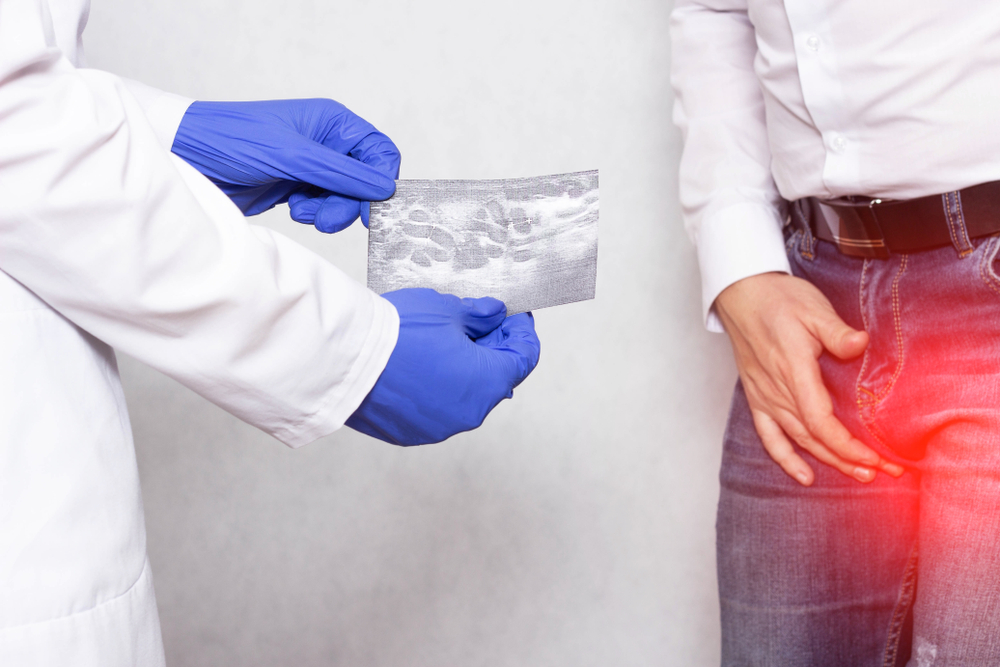A testicular ultrasound is a test that provides images of the testicles and the tissues around the scrotum. The ultrasound is also known as a testicular sonogram. The testicles are the main male reproductive organs. They produce sperm and testosterone, the male sex hormone. The testicles are located in the scrotum, a fleshy pouch of tissues that hang below the penis.
An ultrasound is a safe, painless procedure that is noninvasive. High-frequency sound waves are used to capture images of the organs inside your body.
A probe or transducer is used during the procedure. This hand-held device is used to convert energy from one form to another. The transducer is moved around the targeted body part in sweeping motions. As it moves around the body, the probe will emit sound waves. The waves then bounce around your body’s organs, and the transducer receives them as a series of echoes. A computer will then process the echoes into images on a monitor. Echoes transmitted by normal tissues are different from those transmitted by abnormal tissues. A radiologist can differentiate the echoes, which can indicate conditions from a collection of fluid around the testicles to a solid mass like a malignant tumor.
Why Do You Need an Ultrasound of Testis?
A testicular sonogram is the main imaging method that is used to check and diagnose any abnormalities in the testicles. Your doctor may request the ultrasound for the following reasons:
- To verify whether the lump in your scrotum is an indication of a tumor
- To determine the outcome of trauma in your testicles
- To evaluate testicular torsion
- To identify why your testicles are swelling
- To check and evaluate varicoceles, which are varicose spermatic veins
- To identify the cause of infertility
- To know the position of undescended testicles
The ultrasound will provide the radiologist with real-time images. The data collected from the sonogram can be used in examining the blood flow in and out of the testicles.
Each testicle is connected to your body through a spermatic cord. This tube has an artery and a vein. The spermatic cord also has the vas deferens, the tube that carries sperm to the urethra. By studying the blood flow in the testicles, a radiologist can identify a possible narrowing or blockage. A narrow or blocked spermatic cord interferes with semen flow and hinders fertility.

When Is a Testicular Ultrasound Procedure Used?
A testicular sonogram is used to identify a variety of problems within the scrotum, testes, and epididymis. A doctor will recommend the ultrasound if you have suffered from an injury or you have pain or swelling in the testicles. Below are the specific uses of the sonogram.
The ultrasound is used for testing testicular lumps. If your doctor suspects that you have testicular cancer, the sonogram is the first test to be performed. The test will identify whether the swelling in the testicles is cancerous or not. The ultrasound images will also show the size and location of a node, and the doctor can identify the composition of the lump. Lumps filled with fluid are often harmless whereas solid ones might be cancerous.
Testicular torsion is a severe, painful condition that requires urgent medical attention. The torsion occurs once the spermatic cord, the cord that supplies blood to the testicles, twists. If medical attention is not offered immediately, the testicles might die due to a lack of blood supply. To prevent further damage to the testicles, surgery is required. If you experience severe testicle pain with no cause, visit your doctor immediately.
Epididymitis is the inflammation of the epididymis. The epididymis is a coiled tube behind the testicles that stores and transports sperm. Fluid may build up around the testicles due to inflammation of the epididymis. The inflammation could result in a lump or may swell in the testicles. Carry out a testicular ultrasound in Hialeah if you feel a lump or swelling in your testicles. An infection can also cause epididymitis.
The role of the testicles is to make and store sperm. Any problem with your testicles can result in infertility. Potential issues that result in infertility include injury, illness, infection, or previous surgery.
Undescended testicles are a common problem among young males. As the fetus develops in the womb, testicles should naturally move from the abdomen and rest in the scrotum. This might occur during birth, or it can take up to six months after birth. If the testicles do not settle in the scrotum by the time the child is six months old, consult a specialist. Surgery might be an option. The operation is not complicated since it involves the surgeon moving the testicles down to the scrotum.
Preparing for a Testicular Ultrasound Procedure
There is no special preparation required for an ultrasound of testis. Before the appointment, there are no dietary restrictions or fasting. Before the examination, you will need to take off any clothing below the waist. You may also consider wearing loose-fitting clothing that is easy to take off. During the ultrasound, stay still for the equipment to create clear images of the testicles.
How Is the Sonogram Performed?
The examination is carried out by a radiologist, a urologist, or a sonographer. The ultrasound is an outpatient procedure carried out in the radiology department of a hospital. The ultrasound is about 20 to 30 minutes. The following steps are involved:
- You need to prepare by changing into a hospital gown. You will receive neither sedatives nor anesthesia.
- Lie on your back and spread your legs. The technician may place a towel beneath your scrotum to keep it elevated. Wide strips of tape may be placed across your thighs and below the scrotum. During the procedure, you need to lie still.
- The technician will apply a warm gel on your testicles. The gel allows the transducer to glide over your body smoothly. It also enables the conduction of sound waves. The technician will slide the probe around your scrotum, moving it back and forth. As the technician pushes the transducer against your body, you may feel pressure, and on the tender area, you may experience discomfort. The technician will position the probe in different angles for different views.
- Once the doctor is finished with the examination, he or she will wipe off the gel. The gel dries quickly and does not stain clothing.
Ultrasound Results
The ultrasound images are processed quickly. Your doctor will provide you with the results immediately after the appointment. If the doctor is unable to discuss the results of the ultrasound with you, make a follow-up appointment. Depending on the results, the physician may recommend further medical tests.

Risks of Ultrasound of Testis
An ultrasound of the testis is a low-risk examination. If your testes are swollen, the examination may cause some pain or discomfort. A testicular ultrasound in Hialeah does not use radiation, making it less risky.
An ultrasound of the testes is a safe and effective way to find out what is happening in your body. It will provide a clear idea of the problem affecting the testicles. You can have this procedure done at Carreras Medical Center. Call us today to make an appointment.


